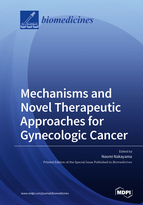Mechanisms and Novel Therapeutic Approaches for Gynecologic Cancer
A special issue of Biomedicines (ISSN 2227-9059). This special issue belongs to the section "Cell Biology and Pathology".
Deadline for manuscript submissions: closed (30 September 2021) | Viewed by 91913
Special Issue Editor
Interests: ovarian cancer; sarcopenia; skeletal muscle index; intramuscular adipose tissue content
Special Issues, Collections and Topics in MDPI journals
Special Issue Information
Dear Colleagues,
The number of patients who suffer gynecologic cancer, such as ovarian cancer and endometrial cancer, has been increasing worldwide. A possible cause of the high lethality of gynecologic cancer includes the lack of early detection tools and effective therapeutic interventions. In this regard, basic research on their pathophysiology and novel molecular-based therapeutic strategies is urgently required.
Recent research has been focused on elucidating the tumor biology and molecular pathways that mediate cancer progression and drug resistance for the development of novel molecular targeted therapies. These include monoclonal antibodies, small-molecule receptor tyrosine kinase inhibitors, and agents blocking downstream signaling pathways in gynecologic cancer. However, the effectiveness of these newly incorporated therapies is quite limited, and further research for better understanding is highly required.
At the same time, the growing evidence of the effectiveness of comprehensive supportive care for cancer patients has been recognized. Recent increased longevity has caused the aging of cancer patients. Along with the invention of novel therapeutic strategies, patients’ tolerability should be taken into consideration, particularly when it comes to older patients. We need to establish more comprehensive therapy and an individualized approach that fits to each patients for their benefit.
In this background, there will be a Special Issue of Biomedicines entitled “Mechanisms and Novel Therapeutic Approaches for Gynecologic Cancer” which will focus on how basic research such as genomics, epigenomics, and proteomics as well as clinical research can contribute to the improvement of the mortality of the gynecologic cancer patients. We would like to welcome basic and clinical research which can show us the possibility of the wide variety of therapeutic approaches for gynecological cancer. In addition to original articles, review articles describing recent interesting topics regarding gynecologic cancer are also welcomed.
Dr. Naomi Nakayama
Guest Editor
Manuscript Submission Information
Manuscripts should be submitted online at www.mdpi.com by registering and logging in to this website. Once you are registered, click here to go to the submission form. Manuscripts can be submitted until the deadline. All submissions that pass pre-check are peer-reviewed. Accepted papers will be published continuously in the journal (as soon as accepted) and will be listed together on the special issue website. Research articles, review articles as well as short communications are invited. For planned papers, a title and short abstract (about 100 words) can be sent to the Editorial Office for announcement on this website.
Submitted manuscripts should not have been published previously, nor be under consideration for publication elsewhere (except conference proceedings papers). All manuscripts are thoroughly refereed through a single-blind peer-review process. A guide for authors and other relevant information for submission of manuscripts is available on the Instructions for Authors page. Biomedicines is an international peer-reviewed open access monthly journal published by MDPI.
Please visit the Instructions for Authors page before submitting a manuscript. The Article Processing Charge (APC) for publication in this open access journal is 2600 CHF (Swiss Francs). Submitted papers should be well formatted and use good English. Authors may use MDPI's English editing service prior to publication or during author revisions.
Keywords
- ovarian cancer
- endometrial cancer
- cervical cancer
- cancer metabolism
- altered body composition
- sarcopenia
- gene regulation
- altered pathway
- precision oncology
- supportive therapy
- immunotherapy
- molecular targeted therapy







